【第七十六回目】
室町砂場:「地味を追及」する蕎麦の名店
Muromachi Sunaba: A renowned soba restaurant that pursues simplicity
Muromachi Sunaba: A renowned soba restaurant that pursues simplicity
| セインさん、今日はにぎやかな神田と、再開発が進んでいる日本橋のちょうど中間、日本橋室町4丁目にある明治2年(1869)創業の蕎麦店「室町砂場」です。 「砂場」というのは、豊臣秀吉が大坂城を築いた時に、建築資材の砂置き場の近くに店を開いて大繁盛した蕎麦屋を皆が「砂場」と呼んだことに始まる名前ですが、この店は、その系譜にあたります。 Thayne-san, today’s destination is Muromachi Sunaba, a soba restaurant established in 1869 and located right between the lively Kanda area and Nihonbashi in Nihonbashi Muromachi, an area undergoing a major redevelopment project. Sunaba is a name that goes back to when Toyotomi Hideyoshi built Osaka Castle. A popular soba shop opened near the piles of sand used for construction, and so everyone called it Sunaba. This shop has roots dating back to that one. |
|
|
「砂場」という名前に、そんな歴史があるとは。おもしろいですね。 I didn’t realize the name Sunaba had such a history. That’s really interesting. |
|
| (松村) | いらっしゃいませ、室町砂場の村松です。 Muramatsu: Hello, I’m Muramatsu from Muromachi Sunaba. |
| こんにちは、村松さん。落ち着いた、いい雰囲気の店ですね。店内の奥にある坪庭もきれいですね! Hello, Muramatsu. Your restaurant has a nice, relaxing atmosphere. And the small garden inside is beautiful. |
|
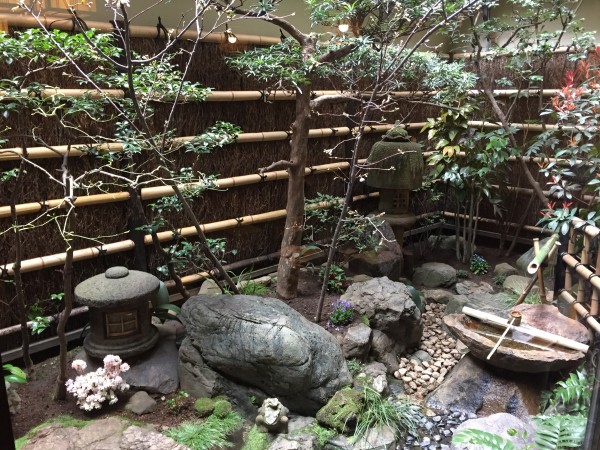 店の外観・坪庭 [Photo] Exterior of restaurant / Small garden |
|
| (松村) |
坪庭は、春には桜、秋には紅葉、冬には雪吊り……と、お客様に日本の四季の風情を楽しんでいただけるように季節ごとに作庭してもらっているんです。 Muramatsu: We have the garden redone each season, cherry blossoms for spring, red leaves for autumn, and yukitsuri ropes for winter so that customers can enjoy each season in Japan. |
| *yukitsuri:https://en.wikipedia.org/wiki/Yukitsuri | |
|
蕎麦は日本の文化ですが、庭や、お店に飾られている日本画などを見たりして、さらに日本を楽しめますね。 Soba is a part of Japanese culture, and the garden and the Japanese art on the walls help us enjoy Japanese culture even more. |
|
| (松村) |
ありがとうございます。 当店は、初代が近くの江戸通り沿いで創業して、ここに移ってきたのが昭和49年(1974)。その店を平成20年(2008)に大改装したのですが、入口や客席が見渡せて、店の者の目が行き届くように1階のレイアウトを大きく動かしたり、2階の個室をすべて掘りごたつ式にしたりして、より居心地よく過ごしていただける店に、そして、より落ち着きのある、和の情緒がある店にと変えてきました。 Muramatsu: Thank you. This restaurant was first founded nearby along Edo Street, and then we moved here in 1974. In a big renovation project in 2008, we changed the first floor layout so that we can look around the entrance or the tables and we can see the customers. We changed all the private rooms on the second floor and put heating pits under the tables. This made it a more comfortable place to spend timeーit’s more relaxing, and it has a more Japanese atmosphere. |
|
一見、古い店のように見えて、建物やインテリアに心配りをされているんですね。もしかして、大学で、建築とか美術とか、そういう勉強をされていたんですか? At a glance, it looks like an old fashioned restaurant, but there’s a lot of care taken with the building and the interior. Did you study anything like architecture or art at university? |
|
| (松村) |
いや、とんでもない。大学では経営学を専攻していましたが、もっぱら教室よりも剣道部に通っていたようなものです。それも自分は剣道があまりうまくないので、練習よりもインカレ(大学の交流戦)などのイベントの企画運営に熱中していました。 Muramatsu: No, nothing like that. I majored in business, but I probably spent more time doing kendo club activities than going to class. I wasn’t very good at kendo, so I was more into planning intercollegiate events and other things than practicing. |
|
へー! Wow! |
|
| (松村) |
私が関わっていたインカレはかなり規模の大きな大会でしたから、様々な仕事が必要になりますし、いろいろな問題が起こります。自分も動きますが、皆に指示を出したり、まとめたり、悩んだり、迷ったり……。今から考えると、たくさんの先輩たちのやり方や姿勢を見ながら、人生の勉強もさせてもらっていたように思います。 Muramatsu: The intercollegiate event I was involved in was quite large, so there was a lot of work to do, and a lot of problems to deal with. I gave directions, organized things, stressed over things, and tried to decide things. When I think about it now, I learned a lot about life by watching the older students. |
|
なるほど。 I see. |
|
|
この店には「家訓」とか「社是」のようなものはあるのですか? Does your restaurant have any company rules or policies handed down from previous generations? |
|
| (松村) | 特にはありません。ただ、手を広げ過ぎず、自分の目の届く範囲で丁寧な仕事をやれ、ということは、父や祖父からよく聞かされていました。老舗は先祖が作り上げてきたものを守り伝えていくだけではなく、変化していくことが大事ですが、その変わり具合をどうしていくかが、当主の裁量です。そのためには、時代にアンテナを張り、たえず勉強していかねばならない、ということは思っています。 Muramatsu: Nothing in particular, just don’t spread yourself too thin, and limit business to what you can see and focus on that. That’s what I often heard from my father and grandfather. Running a family business with a long history doesn’t mean doing exactly what your forefathers did, it’s important to change things, and it’s up to you to decide how to implement change. So I have to stay tuned to the current trends and constantly learn new things. |
|
たとえば、お店のメニューも変わってきたのでしょうか。 Have you changed the menu, for example? |
|
| (松村) |
ええ、随分変わってきたと思います。たとえば、古いメニューを見ると「アイスクリーム」とか「あんみつ」なんていうメニューもありますが、今はありません。つまり、チャレンジ失敗ですね(笑)。失敗作は今に伝わっていないので詳しくはわかりませんが、数限りなくあるでしょう。 Muramatsu: Yes, I think it has changed a lot over the years. For example, when you look at old menus, some of them have ice cream and anmitsu, but we don’t have those things now. In other words, they must have been a failure. They didn’t hand down the recipes that failed, so I don’t know much about them, but there were probably a lot of things like that. |
| *anmitsu: https://en.wikipedia.org/wiki/Anmitsu | |
| では、昔から変わらずに守ってきた、この店の蕎麦の特徴は何ですか? おすすめメニューはありますか? Then what’s special about your soba that has been handed down as is from previous generation? What do you recommend we try? |
|
| (松村) | まず、うちの蕎麦には2種類があります。香り高い、やや黒味がかった蕎麦を「もり」、蕎麦の実の芯だけを挽いた色白の更科粉で打った蕎麦を「ざる」と呼んでいて、昔ながらの丁寧な仕事で蕎麦づくりをしています。これは、これからもこの先も変わらない姿勢です。 おすすめのメニューとしては、江戸前のそばつゆに芝海老と小柱のかき揚げを入れてお出しする「天もり」「天ざる」でしょうか。今では珍しくありませんが、この出し方は当店が発祥です。 Muramatsu: First, we have two kinds of soba here. We call the soba with a strong fragrance and color mori and the pale one made with polished buckwheat zaru. We still make the soba carefully using the old methods. We will always make it that way. The item I recommend is the tenmori or tenzaru, which is made with pre-Edo style broth and battered shrimp and clams. It’s a common dish now, but our restaurant pioneered this way of serving soba. |
|
では、僕は「天もり」を大盛りで注文! In that case, I’ll take a large serving of tenmori. |
|
| 私は、温かい「おかめそば」を。 I’ll have a warm okame soba. |
|
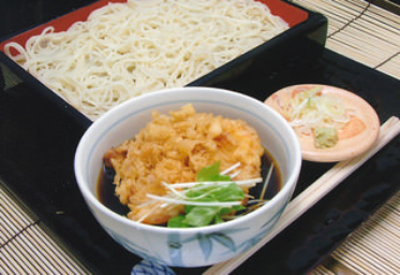 天もり。こしのある蕎麦を、胡麻油でカラリと揚げられた香ばしい天ぷらが浸る濃い口のつゆでいただく。おいしい! 天もり。こしのある蕎麦を、胡麻油でカラリと揚げられた香ばしい天ぷらが浸る濃い口のつゆでいただく。おいしい![Photo] Tenmori. Al dente soba is dipped in strong broth and eaten with crunchy and fragrant tempura fried in sesame oil. Delicious! |
|
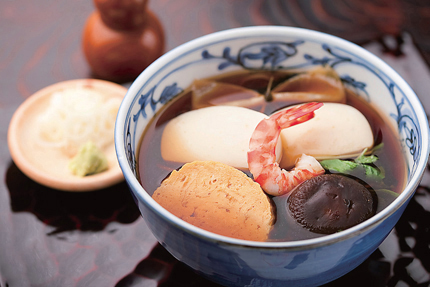 かまぼこや椎茸、海老などの具が、おかめの顔のように盛りつけられている「おかめそば」。つゆのおいしさに、ホッとする。 かまぼこや椎茸、海老などの具が、おかめの顔のように盛りつけられている「おかめそば」。つゆのおいしさに、ホッとする。[Photo] Okame soba. Kamaboko, shiitake mushrooms and shrimp are arranged to make a face on top of the soba. The broth is delicious. |
|
| (松村) | そばつゆで味つけした玉子焼きなどもぜひどうぞ。 Muramatsu: Try some of our fried rolled egg flavored with soba broth. |
| セインさん、この店は、蕎麦以外のお料理のおいしさも評判なんです。定番の玉子焼きや焼き鳥などのほか、旬の野菜などを使った酒肴もあって、そうした逸品をつまみながらお酒を楽しみ、最後はお蕎麦で締める! 日が暮れてくると、そんなお客様で賑わい始めますよ。 Thayne-san, this restaurant also has a reputation for some delicious foods other than soba. In addition to common items like fried rolled egg and grilled chicken skewers, there are also dishes made with seasonal vegetables to eat while drinking, and you can finish off your meal with soba noodles! Later in the evening, the restaurant gets really busy. |
|
| それも日本の文化なんですね。蕎麦は、奥が深いですね。 This is also part of Japanese culture. There really is a lot to soba. |
|
| (松村) | はい。蕎麦は「地味」な食べ物ですが、私は「地味」を追及しようと思っていまして…。 Muramatsu: That’s right. Soba is a humble food, so I think we should try to go deep into that simplicity. |
| 「地味」ですか? Simplicity? |
|
| (松村) | はい。江戸から今に続く名物グルメといえば、寿司、天ぷら、うなぎなどがありますが、いずれも華やかさのあるハレの食べものです。一方、蕎麦は地味でしょ。でも、蕎麦だけは毎日食べても飽きないんじゃないかな、と。 Muramatsu: Yes. Famous gourmet foods from the Edo period onwards are all eye-catching foods such as sushi, tempura and unagi. On the other hand, soba is simple. But I think you could eat it every day and not get tired of it. |
| *Edo period: https://en.wikipedia.org/wiki/Edo_period | |
| なるほど! まさしく細く長く、ですね。今日はありがとうございました。 I see! It’s definitely long and fine. Thanks so much for having us today. |
|
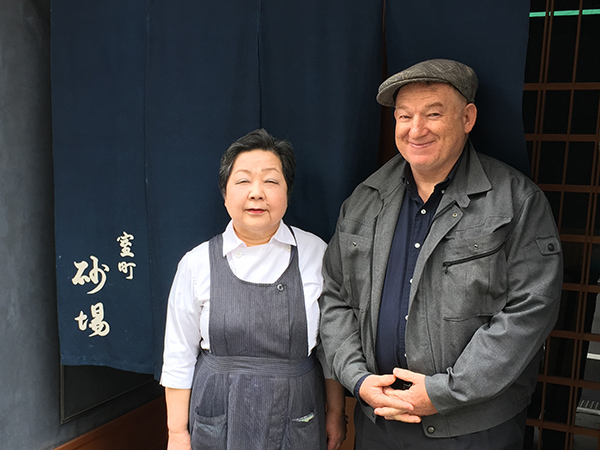 |
|
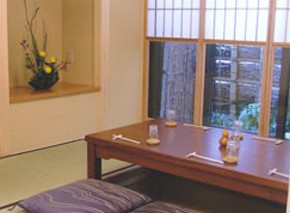 ・ご当主に代わって、フロアーを仕切るお母様と記念撮影。 ・ご当主に代わって、フロアーを仕切るお母様と記念撮影。・2階の宴席では、季節の逸品を加えた特別仕立ての蕎麦会席も楽しめる。 [Photo] A commemorative photo with the owner’s mother who runs the restaurant floor. In the dining seats on the second floor, enjoy special soba meals with seasonal delicacies. |
|
| 店舗情報はこちら | |
| (文)太田美代 (英訳)デイビッド・A・セイン |
 1959年、米国生まれ。証券会社勤務を経て来日し、翻訳・通訳など多岐にわたって活躍。豊富な教授経験を生かし、数多くの英語関係書籍を執筆。近著に『日本人のチョットへんな英語』(アスコム)、『超入門シャドーイング』(主婦の友社)、日本人が使いすぎる英語(PHP文庫)など多数。 下町の魅力に魅了され、自身が代表を務める英語関連のコンテンツ会社のエートゥーゼットのオフィスを根津に構えている。英会話本の執筆をしながら、東京・文京区根津と春日にあるエートゥーゼット英語学校の校長も務める。 http://www.smartenglish.co.jp/
1959年、米国生まれ。証券会社勤務を経て来日し、翻訳・通訳など多岐にわたって活躍。豊富な教授経験を生かし、数多くの英語関係書籍を執筆。近著に『日本人のチョットへんな英語』(アスコム)、『超入門シャドーイング』(主婦の友社)、日本人が使いすぎる英語(PHP文庫)など多数。 下町の魅力に魅了され、自身が代表を務める英語関連のコンテンツ会社のエートゥーゼットのオフィスを根津に構えている。英会話本の執筆をしながら、東京・文京区根津と春日にあるエートゥーゼット英語学校の校長も務める。 http://www.smartenglish.co.jp/







